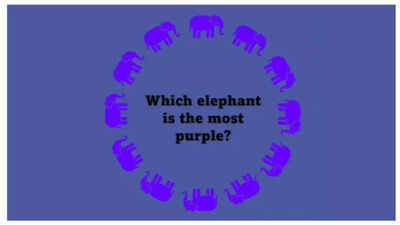
Recently, a new optical illusion sent the internet into a tizzy. In this, a group of elephants were arranged in a circle. While on first look, they all looked to be blue-purple in color (or rather violet), some of them on closer look, appeared more purple than the other. Let’s find out more…The illusion of being more purpleThe image was shared on IG by sciencemagician, who wrote, “Which elephant do you perceive as being the most purple in colour? Does it change?For best results turn your screen brightness up. Works best on newer OLED screens. Sadly won’t work in print. This illusion is based on a new science paper I read by Hinnerck Schultz-Hildebrant. It’s a fascinating combination of mechanisms in our vision system and colour theory. Search for “When Purple Perceived Only at Fixation: A Fixation and Distance-Dependent Color Illusion” to read the paper as a preprint. ” Let’s find out more…More on the illusionHinnerck Schultz-Hildebrant discovered the new optical illusion “When Purple Perceived Only at Fixation” which shows purple areas display their true purple color, when directly observed but turn blue when seen from the side. The color appearance of purple structures depends on both viewing distance and fixation point position, because longer distances can restore purple visibility in certain cases. The brain constructs color perception through this illusion which demonstrates how purple perception works differently than other colors because the fovea lacks direct cone representation for purple.How it worksThe human eye uses fovea central vision to process color information which creates this illusion.S-Cone Absence: The fovea contains minimal S-cones which function to detect blue light. The brain needs to create purple perception through signal reconstruction, when we focus on a point because the fovea lacks sufficient blue light detection.The brain uses peripheral cone signals together with contextual information to interpret purple as blue, when the eyes move away from the central viewing point.The distance between the viewer and the subject determines which purple elements will appear purple again, because fixation distance affects visual perception.Why it is so interestingThe brain’s adaptation process to stimulation becomes visible through this illusion, because it demonstrates how color perception transforms based on time and environmental conditions.The illusion demonstrates advanced knowledge about color theory and visual system operation, because it shows how the brain builds color perceptions from eye signals.The brain generates deceptive perceptions through this contemporary optical illusion, which demonstrates its ability to create misleading perceptions from received information.Types of optical illusionsThere are three main types of optical illusions:Literal Illusions: These occur when the brain combines elements of an image to create something that doesn’t exist. For example, an image might look like two faces or a vase depending on how you interpret it.Physiological Illusions: These are caused by overstimulation of the visual system, such as excessive exposure to light, movement, or color. They can create effects like afterimages or motion illusions.Cognitive Illusions: These rely on how the brain subconsciously interprets information. Examples include illusions like the Müller-Lyer illusion, where lines appear longer or shorter due to surrounding shapes.







